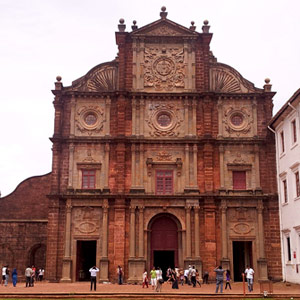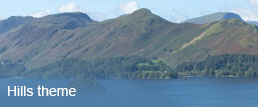What to See
Beaches at North GoaArambol: Located close to Mapusa, Arambol is the site of several adventure activities in Goa. The beachfront is lined with shacks and stalls that offer Goan snacks and great shopping options. Visit the Paliem Beach, which also has a tiny freshwater lake, fed by springs located at the base of the hills. The Keri Beach is palm-fringed and has several shacks and food stalls lining it, making it the apt picnic spot. You also the options of indulging in some great adventure sports including dolphin-spotting, windsurfing and paragliding, which are arranged by the clubs located on the beach. An interesting site you can visit is the Tiracol Fort located north of Arambol, now converted into a hotel. The St Anthony’s chapel is open for guided tours and the ramparts offer splendid views of the region.
Open from: Tiracol Fort – 6.30 am-9.30 pm for 30 minutes tours

Mandrem-Ashwem-Morjim: These three beaches are divided by tiny creeks and constitute the quieter of all other beaches. Mandrem is best explored on foot; you must visit the Organic Farm, which grows and sells fresh organic fruits and vegetables. There isn’t much of watersports options except occasional dolphin and crocodile spotting excursions. Ashwem Beach, with its profusion of shacks, budget hotels and local restaurants is home to backpackers. It would be a particularly exciting trip to Morjim Beach, which is the breeding ground for the Olive Ridley Turtles, managed by a group of volunteers.
Vagator: This is known for the Chapora Fort, which dominates the skyline of the beach. The site of many Bollywood film shots, Vagator Beach is marked by red cliffs and fresh water springs, against the backdrop of stalls selling trinkets, t-shirts and sarongs. Explore the area of Ozrant, which has an interesting stone carving of Lord Shiva’s face. Vagator’s most defining structure is the Chapora Fort, which is accessible from the sea-face. The fort, which offers breathtaking views, is not maintained too well, so you need to be careful when exploring the ramparts. The Chapora Village is set away from the beach and has tiny shops and stalls selling fresh fruits, vegetables and breads. Closeby is the Chapora Fishing Jetty, where you can try your hands on some angling and indulge in dolphin-spotting activities.
Anjuna: This is one of the most frequented and hip beaches in Goa, and you would find all kinds of people coming here. Anjuna’s best highlights are the beach parties that happen on full moon nights and its Wednesday Flea Market, where a whole world of trinkets and souvenirs are available. The beach is overlooked by a red cliff and is full of rough stones and boulders set amidst swirling waves. There isn’t much watersports activities, except occasional snorkeling when parrotfish and mullet might be visible. Also located closeby is Siolim Village, which is known for its annual Sangodd and Zagor Festivals.
Calangute: The discovery of hippies, Calangute is said to be the Queen of Beaches in Goa. The Baga-Calangute-Candolim stretch is frequented by tourists and shops selling a whole range of interesting buys. The Calangute beach is a haven for watersport activities, including parasailing, water-skiing, banana and bump rides. You can also contact the boat operators who organise crocodile and dolphin spotting, fishing and trips to nearby islands. Also accessible from the Anjuna Beach, Baga is lined with restaurants and shops, and is home to the famous Club Tito’s and Café Mambo. Arpora Village near Baga is known for its exciting Ingo’s Night Market, where, along with the usual trinkets, you also have options of tattoos, body piercing, tarot-reading, wood carvings and sculpting. Candolim is a relatively quiet beach and is home to the Chapel of Saint Lawrence, dedicated to the patron saint of sailors. The stark white Candolim Church is dedicated to Our Lady of Hope and has stained glass panels. Other quiet beaches near Candolim include Coco Beach, Reis Magos and Queg de Velim Beach. All these beaches have selective hotels where you can stay and some well-spread shacks offering great Goan cuisine.
Miramar-Dona Paula: Miramar Beach is the site of the confluence of the Mandovi River and the sea and is full of tourists and picnickers every evening. The Gaspar Dias Circle was home to a fort by the same name, which used to guard the Mandovi River entrance. The single-steeple Cabo Chapel is open to the public for Christmas Eve midnight mass. Made up of three beaches, Dona Paula offers sailing activities and great views of the Mormugao Harbour and Arabian Sea. At the base of the hillock is a sculpture depicting a man facing west and a woman facing east. Beaches in South Goa
Bogmalo: This is one of Goa’s more attractive golden beaches bound by green hills. A little before you reach Bogmalo, visit the little cove and beach of Issorcim, which is an extremely secluded beach and the only place where plate coral grows. Of course, these are visible only when the water is clear. The Sao Jacinto Island is home to old quaint houses and a beautiful chapel. The Chicalim coastline is known for its huge number of fresh clams, which are collected for the coconut milk curry. Too many watersport activities are not available here, though you can try your hand on basic diving activities.
Velsao-Betalbatim: This is the quietest of all beaches in Goa and only features Sunday picnickers as the crowd. The Velsao Beach is made of green hills and coconut groves, lined with fishing huts and sardine fishing options. Velsao is best explored on foot and you must visit the Velsao Chapel dedicated to Our Lady of Cures, and which also offers great views of the sunset. The Arossim Beach is home to the Cansaulim Village, Cansaulim Church and the well-preserved house Casa dos Roldao de Souza. Majorda Beach is a larger village, though accommodation is limited. The Utorda Beach is located 1 km from Majorda and has quite an interesting range of hotels. The Betalbatim Beach gets its name from the demon Betaal, whose temple once existed at Fardo Village. Betalbatim is also home to the recently renovated Church of Our Lady of Remedios.
Colva-Benaulim: Colva is South Goa’s most happening beach, especially for shopping and nightlife. The beach is full of shacks and restaurants serving vindaloo, xacuti and feni, and boat clubs offer dolphin-spotting activities. The Colva Church is dedicated to Our Lady of Merces, and its most striking feature is the image of the Infant Jesus, which is believed to have miraculous powers. If you must have a dip, do so at the relatively isolated Sernabatim. Benaulim Beach is similar to Colva with its lines of shacks, where you can chill out with a beer or feni. The village houses the St John the Baptists Church, which is notable for its pure white marble interiors. In Benaulim, you’d find ornamented wooden altars and idols or saints at every church and house, which are the handiwork of the local carpenters.
Palolem: Palolem Beach is located in the Canacona region of South Goa. This is also one of the best areas for catching glimpses of the dolphins. Palolem Beach has a large cup-shaped rock called Pandava’s Drum, so named because of the sound it emanates when you throw a stone of it. Located a little away from the beach, Figueiredo House is an old beach house built in the 20th century. The Island at the end of the beach offers great snorkeling opportunities, where you could find mussels, sea urchins and sea cucumbers. Located closeby, enjoy interesting watersports at the Patnem-Colomb Beach. Rarely visited, but just as peaceful are the Agonda Beach, Cola Beach and Canaguinim Beache.
Panjim: This is possibly your base to exploring the treasures of Goa. Panjim is best discovered on foot, as you walk in the old-world lanes, past heritage houses and ancient markets selling an amazing range of goodies. Located centrally in Panjim, Altinho offers spectacular views of the city. It is one of the quietest areas and only has a few ancient houses, the Bishop’s Palace and the Jogger’s Park. The Bishop’s Palace is especially beautiful during Christmas, when star lanterns are hung on the trees and a huge mass is conducted. The Jogger’s Park also offers spectacular views of the city and has a Maruti Temple, which is lit up in the evenings. Panjim’s most recognized feature is the Our Lady of the Immaculate Conception Church, which has double staircases rising from the main church square. The interiors are beautifully done and two gilded and carved altars are placed before the main altar. The church bell located in one of the towers is said to be among the largest in the world. The Fontainhas is one of the prime cultural centres, which houses evidences of the life and history of Goa. The Kala Academy houses two mini theatres, which conduct regular workshops, a music library, an art gallery and exhibition rooms. While in Panjim, also try and get a boat cruise through the River Mandovi and you just might be lucky to spot a dolphin or two.
Open from: Kala Academy - 9.30 am-5.45 pm; Cruise – 6.00 pm-7.00 pm, 7.15 pm-8.15 pm, 8.30 pm-9.30 pm
Goan Churches: The entire landscape of Goa is dotted with a number of churches, each with a story of its own. Among the most popular is the Basilica of Bom Jesus, which houses the relics of the Goan saint, Francis Xavier. This church is intricately carved in a baroque Renaissance-style. The relics of the Saint are housed in a protected casket and put up on public display once in 10 years. The Sé Cathedral, with its distinctive Tuscan exterior houses the famous Golden Bell in one of the towers and exquisite filigree work adorn the screens. Built in Indo-Portuguese style, the Church & Convent of St Francis of Assisi sports bold floral designs, a gilded altar and inscribed tombstones. Within the church is an Archaeological Museum, which houses portraits of Goan viceroys and governors and other memorabilia of the Goan life and times. Close to the Francis Assisi Church is the Chapel of St Catherine, which is another Renaissance-style chapel with square towers. The Church of Our Lady of the Rosary is particularly interesting for its Indian motifs, like cashewnuts, mangoes and flowers that adorn its walls. Another architectural marvel is the Royal Chapel of St Anthony, which has a distinctive fort-like appearance and is extremely ornamented from within. Also visit the ruins of Church & Monastery of St Augustine, which only has the belfry of its once 150-ft tower remaining.
Open from: Basilica of Bom Jesus – 6.00 am-6.30 pm
Sé Cathedral – 7.30 am-6.00 pm
Goan Temples: Among the better-known temples is the Mahalsa Temple in Mardol, which is dedicated to Mohini, the female form of Vishnu. Its highlight is the 21-tiered deepmal, placed atop the tortoise. Elaborate carvings adorn the temple walls and heavy woodwork defines the Shikhara. The Mangueshi Temple in Priol was originally dedicated to Lord Shiva; today it houses quite a few gods of the Hindu pantheon. Painted white and yellow the deepmal here is a stunning seven-storey. One of the most popular temples is the Shantadurga Temple, dedicated to Goddess Parvati. Done in white and red, a four-storey domed tower adorns the temple top. A 5-storeyed deepmal is located inside the complex and huge chandeliers are suspended from the ceiling. Also visit the Ramnath Temple in Kavlem, which houses a lingam within. Especially watch out for the silver screen in the sanctum, which has elaborate carvings of animals and floral motifs.
Goan Forts: Fort Aguada is one of the most important forts overlooking the Aguada Bay and Mandovi River. This fort once had almost 79 cannons and the arched entrance has a citadel and lighthouse. Also check out the prison cells, which are located at the lowest level of the church – these, however, are kept locked. The Reis Magos Fort was used as a prison and offered great views of the sea. Overlooking Panjim, the Cabo Fort was one of the most imposing structures. However, today only 3 large cisterns remain. The Mormugao Fort originally had 5 prisons, a chapel, rooms for the guards, 20 bulwarks and 3 magazines. However, today, all you would find the chapel and a part of the boundary wall. Also visit the Cabo Da Rama, which though in ruins, affords awesome views of the sea.
Vasco Da Gama: Vasco houses the Dabolim Airport and is one of the most active areas in Goa. The Pilot Point is the best area to catch unhindered views of the place. One of the few natural harbours in India is also located here, called the Mormugao Port. You can also hire the services of the ferries who engage in sightseeing activities. The Japanese Garden is located close to the Pilot Point and houses the ruins of the fort. The Garden has steps leading to the beach. En route you’d come across a temple dedicated to Durga and another dedicated to Lord Shiva. Don’t miss the Naval Aviation Museum, which has on display aircraft and weapons used by the Indian Navy. Especially interesting would be the Super Constellation and a Sea Hawk with folding wings. Also available are flight simulator video games.
Open from: Naval Aviation Museum - 10.00 am-5.00 pm (Mondays closed)
Entry fee - Rs 15
Margao: Margao is one of the best old-world areas in Goa, complete with bright green fields against the backdrop of hills. Interesting features of Margao include the Town Square, which has a Library housing books in Hindi, English, Konkani and Portuguese. The Church of the Holy Spirit was done in baroque-style architecture and features a dome and towers on either side. The Grace Church features the crucifix of the resurrected Christ draped in a shroud. Temples in Margao include the Damodar Temple, the Hari Mandir and a more recent Ram Mandir.
Mapusa: Mapusa is more synonymous with the Friday Market, which is definitely a not-to-be-missed scene! Brightly dressed women travel here from far and near with a whole range of interesting articles for sale. These include utterly cheap clothes, fresh organic fruits and veges, Goan red rice and the absolutely yummy Goan sausages. A much-revered temple here is the Bodhgeshwar Temple, whose main deity was believed to have miraculous wish-granting powers. The Swiss Chapel is a rather modest structure sporting a cream and blue altar and shrine, and is the site of a Holy Cross Feast towards the beginning of Lent.
Top Hotels in Goa
- Estrela Do Mar Beach Resort
- Resort De Coracao
- North 16 Goa
- The Zuri White Sands Goa Resort Casino
- Resorte Marinha Dourada
Top Landmarks in Goa
- Hotels Near Dudhsagar Falls
- Hotels Near Titos Lane
- Hotels Near Thivim Railway Terminus
- Hotels Near Madgaon Rly Stn
- Hotels Near Verna Industrial Estate






